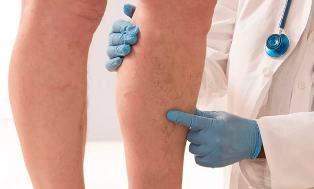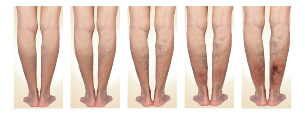
From the article you will learn what signs may indicate varicose veins of the lower extremities, the causes of the pathology, treatment and prevention at home.
WHAT IS VARICOSIS?
Varicose veins is a vein pathology, based on a malfunction of the vascular valve apparatus with the formation of venous insufficiency, expansion of the lumen, congestion, which are accompanied by constant tissue pastiness.
MAIN CAUSES OF THE PATHOLOGY
Varicose veins in the legs have different causes and symptoms, which have minor gender characteristics.The main common trigger of pathology is called congenital weakness of the connective tissue.In second place are hormonal changes, so women are diagnosed with varicose veins more often. A prolonged static position, sitting or standing, plays a role, while the longer the legs, the more serious the situation. Extra pounds also provoke an increase in pressure in the veins of the lower extremities, as well as a lack of physical activity. Smoking, pregnancy, concomitant pathologies, tight underwear, shoes, heels, everything that causes stagnation of blood circulation in the veins in the legs are risk factors for varicose veins.
SYMPTOMS AND CLINICAL MANIFESTATIONS

The signs of varicose veins in women and men do not differ fundamentally. This is a staged disease, the symptoms of which are correlated with the stage in the development of the pathological process.
The first stage is characterized by minor clinical manifestations: veins barely protrude above the surface of the skin, the dermis is slightly hyperemic, heaviness in the legs begins to bother, evening pastiness of the legs, ankles, convulsions are possible. Such symptoms of varicose veins of the legs are especially painful for women from an aesthetic point of view. Pain is often preceded by visual signs.
At the second stage, the clinical picture takes on a typical appearance: veins on the legs protrude prominently above the skin surface, are well palpated, resemble nodes. If the pathological process progresses, the veins of the lower extremities acquire sinuous shapes, a bluish-purple hue, sometimes they turn black.
The symptoms of leg varicose veins of the third stage are characterized by the development of complications: trophic disorders appear, the skin resembles parchment, edema and cramps become common, the legs become covered with a rash, begin to itch, secondary flora joins, pyoderma layers, dermatitis, eczema.
The fourth stage of varicose veins of the lower extremities is the most severe in terms of symptoms: the skin over the bulging veins becomes inflamed, nearby tissues are involved, trophic ulcers open, pain in the legs with varicose veins is permanent, the addition of a secondary infection provokes thrombosis, thrombophlebitis, urgenthospitalization, complex treatment.
WHAT DOCTOR TO CONSULT?
A phlebologist deals with pain in the legs with varicose veins, but a vascular surgeon can also conduct the initial appointment. It all depends on the severity of the pathology. The phlebologist prescribes conservative therapy or refers to a vascular surgeon for consultation to resolve the issue of surgery.
Without a complete clinical and laboratory examination, it is not possible to make an accurate diagnosis. Instrumental diagnostic methods help to clarify the stage of pathology, the duration of tests takes 10 minutes, maximum - half an hour. The result of the examination is announced by the doctor immediately, at the first appointment. The choice of adequate therapy depends on the stage of the pathology.
TREATMENT FEATURES
Therapy for varicose veins lies on the "three pillars": drug treatment, minimally invasive techniques, operational classics.
CONSERVATIVE THERAPY
In addition to the mandatory general recommendations for varicose veins: dosed, regular physical activity, minimization of static load on the legs, exercise therapy, wearing compression hosiery, the use of elastic bandages - conservative therapy involves the appointment of phlebotonics based on flavonoids, horse chestnut extract. These are tableted systemic drugs: synthetic and based on natural ingredients.
Most often, oral administration is combined with the same name external therapy for varicose veins. According to doctors and patients, the combination of capsules and gel is most effective.
Of course, one should not expect a complete cure from conservative methods, drugs are not able to restore dilated veins, but as a prophylaxis, in preparation for surgery, the impossibility of surgical treatment of varicose veins - these drugs guarantee a suspension of the progression of the disease and alleviate symptoms.
COMPRESSION SCLEROTHERAPY
The essence of minimally invasive therapy for varicose veins is to inject a special sclerosant drug into the dilated vein. Through a syringe, the doctor injects a foamy solution into the vein, which fills the deformed vessel, spasming it.
The patient is put on a compression stocking, which is designed to keep the vessel in this state. Within three days, the walls of the veins stick together, the vessel is turned off from the usual blood flow and empties. You need to wear compression hosiery for at least a month, sometimes two. The criteria for the effectiveness of the treatment are the formed adhesions.
Compression sclerotherapy is performed if varicose veins are not complicated by reverse blood flow from deep vessels to superficial ones through communicating veins.If such a counterflow is present, the effectiveness of the procedure tends to zero.
OPERATING INTERVENTION
Operation - has been and remains the most reliable and effective way to treat varicose veins, regardless of the presence of reverse blood flow in the veins. But even here it is important to consult a doctor in time, since relapses often occur in the later stages. Varicose veins are operated with different techniques: microsurgery, radiofrequency and laser coagulation of deformed veins.
In the initial stages, photocoagulation or laser removal of spider veins is effective. In the later stages, phlebectomy is indicated - complete removal of the affected veins. The operation is traumatic, there is a risk of complications, so today doctors are trying to use the technique of less invasive miniflebectomy. If varicose veins are complicated by vein thrombosis, secondary infection,crossectomyis performed.
WHAT CAN YOU DO WITH VARICOSIS OF THE FOOT AT HOME?
The essence of using folk remedies for the prevention and treatment of varicose veins comes down to removing toxins and toxins from the body with the restoration of normal blood flow. To do this, they balance the diet, including cabbage, tomatoes, bell peppers, herbs, citrus fruits, apples, peaches, cherries, cherries, strawberries, gooseberries, currants in daily dishes. The correct drinking diet must be calculated: 40 ml per kilogram of weight.
In addition, they use the properties of green tomatoes, which are tied in slices to the area of varicose veins in the form of compresses. The effect is guaranteed by lycopene - an antioxidant in the fruit pulp, which improves the structure of the vascular wall, tones the veins. You can try the juice treatment: all vegetables that are eaten raw are suitable.
An extract from garlic and lemon is effective: phytoncides dissolve cholesterol plaques, clearing the lumen of blood vessels, a natural antibiotic, which is garlic, kills pathogenic flora, and vitamin C strengthens the vein wall, prevents salt deposition. The tincture is prepared simply: chop 4 unpeeled lemons, 4 large heads of garlic, put the mixture in a jar, fill it with warm boiled water, insist under the lid for three days, shake the container daily, filter, store in the cold, drink a third of the glass during meals three times /day. Course - drunk 12 liters of the resulting solution.
Apple cider vinegar is popularly considered a source of minerals and vitamins; for varicose veins, it is taken orally in the morning and evening by dissolving two teaspoons of the product in a glass of water. Outwardly: rub the varicose veins with a tampon soaked in vinegar to relieve itching and pain.
Compresses are made with honey, applying a sterile napkin with the product to the area of varicose veins for a couple of hours under a film. Use broken cabbage leaves with vegetable oil under a bandage overnight. Course - month.
PREVENTION
Prevention of varicose veins has two goals: to prevent the onset of the disease and reduce the number of relapses. For this: you can not go to the sauna or take too hot baths, lift weights. It is recommended to move a lot, excluding strength sports, control weight, and minimize the consumption of too spicy and fatty foods.
No need to wear tight clothes, socks, knee-highs, stockings with a tight elastic band, cross your legs while sitting. Women are encouraged to give up high heels.
At night - take cool foot baths, you can douse your feet with cold water in the morning. It is necessary to abandon bad habits, to master the point self-massage: stroking the skin of the lower extremities from the bottom up and in the opposite direction for 10 minutes, minimize stress, avoid overheating, colds, undergo medical examination.
In case of varicose veins, it is reasonable to visit the pool, walk on foot, take a contrast shower at home, and constantly wear compression hosiery.



































